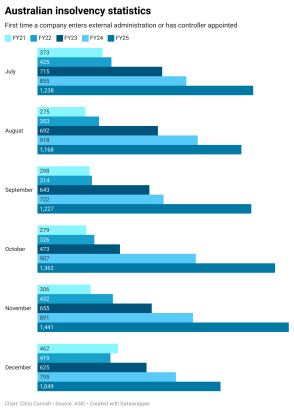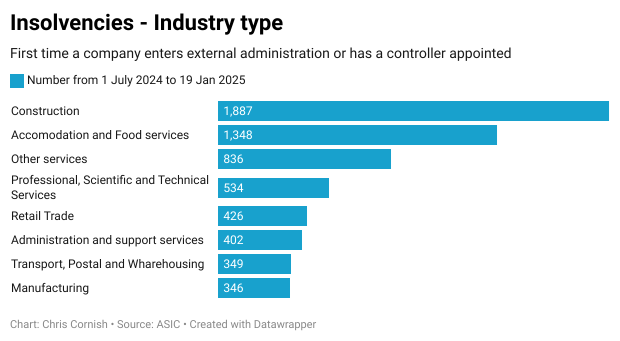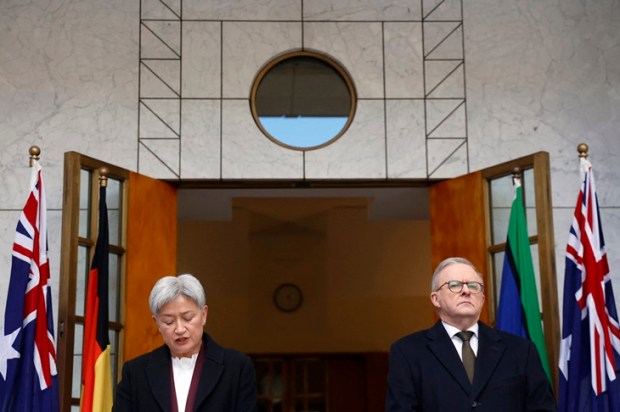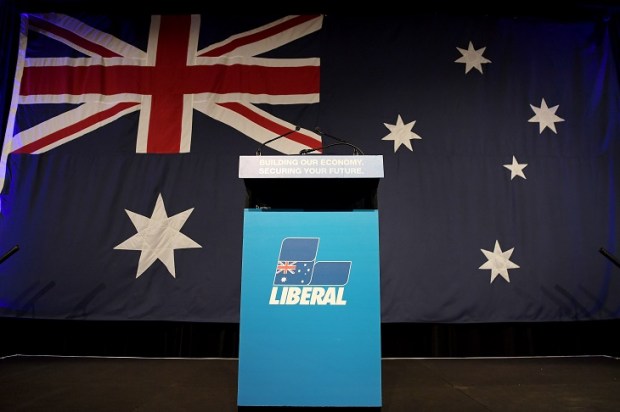ASIC released their latest insolvency statistics earlier this week and the results are concerning.
A company becomes insolvent when they can’t pay their debts when those debts become due for repayment.
When this happens it’s common for an external administrator to be appointed who will then take control of the business and attempt to maximise the amount of debt that can be repaid.
What concerns me from the latest ASIC statistics is that for the first half of this financial year, first-time insolvencies are up 42 per cent from the same period last financial year. And for the same time period, last financial year was up 33 per cent on the financial year before. So we have a worrying trend of significant increases in business insolvencies.
The graph below shows the number of companies that had an external administrator or controller appointed for the first time.

The construction industry makes up the largest component of first-time insolvencies, and of this over 60 per cent are small businesses with less than five full-time employees. This is closely followed by ‘accommodation and food services’ (hospitality), which again mainly consists of businesses with less than five full-time staff. Retail and ‘professional, scientific and technical services’ are also industries high on the list.
As of January 19, 2025, the eight largest industries for companies first entering external administration are:

The reasons we are seeing these increases in insolvencies include higher interest rates, higher inflation, weak consumer confidence, excessive government regulation, and high energy costs.
Specific focus of the last two points is warranted.
A perfect illustration of excessive government regulation is the Therapeutic Goods Administration initiated packet change to paracetamol which occurred on February 1. No more can supermarkets, petrol stations or convenience stores sell packets of 20 headache tablets; instead they must be sold in packets of 16 tablets. This thought bubble, which occurred after two rounds of community consultation, an independent expert report and advice from the Advisory Committee on Medicines Scheduling likely cost taxpayers a small fortune to conduct, and implement the necessary changes to the Poisons Standard. And nary a thought would have been given to the retailers who had to send 20-pack stock back to their wholesalers, the wholesalers who have had to destroy the stock or the manufacturers who have to pay for new packaging and adjust their manufacturing processes for 16 tablets instead of 20. The pointlessness of this is laid bare by the fact that we can simply buy two packets, or visit two supermarkets, or buy the larger packs from the chemist. Great cost has been incurred, but little, if anything, has been achieved. And what a mockery it makes of Anthony Albanese’s battle on shrinkflation. I think we all know the packet of 16 headache tablets won’t be cheaper than the 20 packet; if anything it will be higher in order to recoup the increased costs which the government created.
Will Kingston, host of the The Spectator Australia’s brilliant Fire at Will podcast, recently interviewed Jon Moynihan about his book, Return to Growth: How to Fix the Economy which analyses the UK’s decades-long stagnant economy and looks at what can be done to resuscitate it. Baron Moynihan says a policy priority to kick start growth needs to be to ‘cut swathes of regulation’. This is certainly true in Australia as well, businesses are inundated with pointless and unnecessary regulation and red tape, created by hordes of public servants. And unfortunately, our politicians have failed to keep a leash on the bureaucrats, and thereby failed us. Of all of Trump’s actions, surely the ‘10 to 1 deregulation initiative’ is the one most needed in Australia.
As to energy, economies flourish when there is cheap and reliable energy. And despite Australia having the potential for cheap energy, Alan Moran shows us our electricity prices are among the highest in the world. This is despite Labor spending billions in its pursuit of Net Zero – the dollars being spent are simply not delivering lower energy prices.
New West Foods, the largest independent food distributor in Western Australia, has faced a doubling in its electricity bill over the past three years to $30,000 a month. Damon Venoutsos, the Managing Director, wrote on Linkinin, ‘Soaring energy prices are impacting the food service supply chain, driving up costs for businesses and, ultimately, consumers.’
In another story on Adelaide bakery Vili’s, whose annual power bill is moving from $500,000 to a potential 22 per cent rise, even the ABC acknowledges that food prices are increasing due to power prices. The alternative to food price increases is the company absorbing the cost, which is what an ice cream maker had to do when their electricity went up almost 50 per cent.
Not all Australian companies are able to wear these rising costs. The trend of increasing company insolvencies is clear. As too are the steps to help reverse the trend. In order to prevent invested money being wasted, and people losing their jobs, the government needs to reduce regulation, reduce energy costs and reduce their spending – which in turn will help lower interest rates and inflation.
Chris Cornish is an independent financial adviser based in Perth. This article does not constitute and is not intended to be financial or other advice.

























